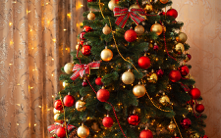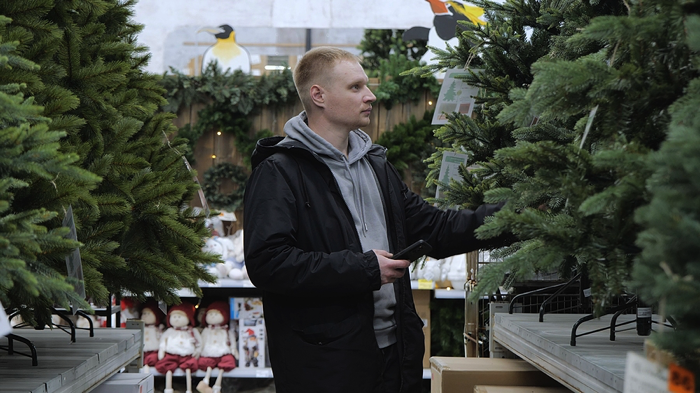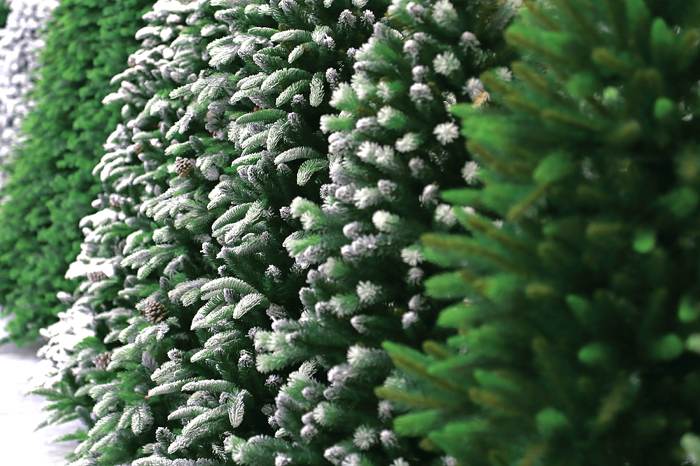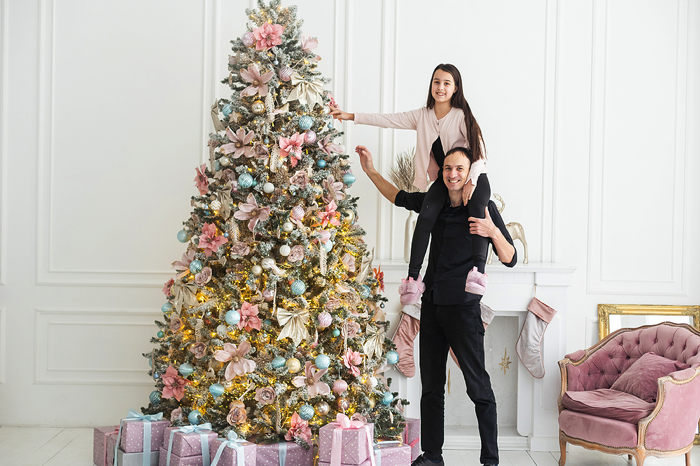 With Christmas around the corner, Black Friday is the perfect time to buy an artificial Christmas tree and save some money in the process. Whether you’re after something that looks real and traditional, a snow-covered option, a bright pink tree, a tree with warm white lights, a tree with coloured lights, a tree with no lights at all – there are endless options to choose from in the online Christmas tree marketplace. We’ve put together a handy buying guide for important points to consider before you make your purchase, as hopefully, this tree be with you for a fair few Christmases going forward.
With Christmas around the corner, Black Friday is the perfect time to buy an artificial Christmas tree and save some money in the process. Whether you’re after something that looks real and traditional, a snow-covered option, a bright pink tree, a tree with warm white lights, a tree with coloured lights, a tree with no lights at all – there are endless options to choose from in the online Christmas tree marketplace. We’ve put together a handy buying guide for important points to consider before you make your purchase, as hopefully, this tree be with you for a fair few Christmases going forward.
See Also: Gifts & Christmas Gift Sets
Shops With Christmas Tree Offers
Artificial Christmas Tree Buying Guide

Christmas comes but once a year, yet that doesn’t mean that you need to be buying a new tree every six months. Instead, you can look to the world of artificial Christmas trees for a sense of how best to spend your money in a way that will allow you to keep re-using your tree each time Father Christmas comes calling. In a world of environmentally conscious buying, doing your bit for the environment isn’t just likely to be cheaper but is also something that a lot of people are keen to try to make sure that they do with their Christmas tree purchasing options.
Why Artificial Over Real Trees?
It is believed that the Germans during the Renaissance period were the first to begin adding decorations to their trees before bringing them into the home. Ever since then, the tradition has become more and more popular, spreading around the world and becoming an important part of the Christmas tradition for families. Both the pagans and Christians have used evergreen fir trees to symbolise the nature of living in the dead months of winter, but for some people, the idea of having to buy a new tree each year is something that seems both expensive and pointless.
Whilst those who buy a real tree will be finding themselves choosing between firs, spruces and pines, people opting for an artificial tree instead will be able to avoid having to clean up the fallen pine needles in the post-Christmas weeks. The other thing you can do if you opt for an artificial tree is put yourself in a position whereby the tree that you use will be identically every year; presuming, of course, that you don’t lose any branches when you pack it away at the end of the festivities and stick it up in the loft ready for another Christmas 12 months later.
The Different Types of Artificial Trees

If you’ve decided to take the plunge and buy yourself an artificial tree, you might well be confused by the sheer volume of options that are in front of you. Yes, there are plenty of different options when it comes to real trees too, but ultimately they are all roughly the same size and shape. When it comes to artificial trees, on the other hand, the very nature of them not being real is such that the manufacturers can do all sorts of things with them, from making them different shapes and sizes to changing their colours or even putting lights inside the tree itself.
The first thing that you’ll want to do is choose the material that your artificial tree is going to be made out of. Artificial Christmas trees tend to be made from one of two types of plastic, with the first being PVC and the second being PE. PE is the abbreviation for polyethylene, which is the sort of plastic that tends to be used in packaging, such as plastic bags and bottles. The biggest difference between the material types is in how they look, with PVC needles being attached to the branch with wires, whilst PE trees are fabricated to mean that they look most like a real tree.
In other words, if you want a fake tree that looks most like a real one then you’ll want to look out for trees made from polyethylene rather than polyvinyl chloride. Of course, the fact that they look more realistic also tends to mean that they’re more expensive, having seen moulds of real trees used in their construction. The needles are 3D, meaning that they’ll look real without the need to get rid of a load of them from the floor at the end of the Christmas period. PVC trees will have needles, of course, but they won’t look anywhere near as realistic if that is important to you.
Think About Tree Size
If you were to go shopping for a real tree, one of the things that you’d consider is how tall the tree is. After all, there is no point buying a 12-foot tree if your ceiling is 8-foot from the floor. Exactly the same consideration should go into buying an artificial tree, given the fact that you should really leave a gap of about six inches between the top of your tree and your ceiling. The majority of people will have a ceiling that is 9-foot up from the floor. With this in mind, a tree any bigger than seven and a half feet is going to cause trouble if you also have an angel or similar to go on top of the tree.
Depending on where your tree is going to go, you will want a tree of between seven and seven and a half foot if you live in a standard house. If you want a miniature tree for on top of a desk or similar, getting one under five foot will be the best thing to do. Smaller living areas will be able to fit a tree up to five and a half foot, whilst homes with low ceilings might be able to stretch to six and a half foot. Rooms with high ceilings might be able to go as high as 12-foot, but do think about any tree topper that you might have and what that will mean for the ultimate height of the tree.
What Shape Do You Want?
The beauty of artificial trees is that you can pick from any number of different shapes as well as sizes. This might be important depending on what the space is like that you’re trying to install your artificial Christmas tree. Regular, full trees are the ones that look most like a real tree, following their profile and shape, being like an upside down V. Full and plump, they are the ones that are most likely to ‘trick’ others into believing they are real, if that is the sort of thing that matters to you. There are slimmer and more slender trees that can fit into tighter spaces.
Should you be particularly lost in terms of space, you can opt for a flat-back tree. These are exactly as they seem, being effectively half-trees. They are ideal for space-saving, given that they can be put up against a wall to give the impression of a tree when there isn’t one there. The good news is that you can also save money on decorations, given the fact that you’ll only need to decorate half of a tree. Whilst the history behind upside down Christmas trees is believed to date back to the eighth century, they’ve definitely become more popular since artificial trees became more common, so that’s another option to consider.
Pre-Lit Trees
One of the beauties of artificial Christmas trees is that you can opt for ones that are pre-lit. They are, as you might imagine, more expensive, but they do remove the time and stress of trying to add your own lights to the branches of the tree once you’ve got it erected. Anyone who has sat for hours trying to untangle the lights that they put into the loft 12 months before will appreciate just how much easier life is if your tree can simply be plugged in, turned on and the lights will go on without any of the associated faff. Of course, pre-lit Christmas trees come with their own issues.
For starters, you will need to decide what type of pre-lit Christmas tree you want, with LED lights or incandescent ones being the main things that you’ll want to choose between. LED lights are likely to consume less electricity, as well as produce less heat than the incandescent bulbs. Incandescent lights, meanwhile, are more likely to cost less in the short-term, so that is something that you’ll have to weigh up before you buy your pre-lit tree.
You should also consider what colour of lights you want as they normally come in bright white, warm white or more colourful. Most of them usually also come with a setting where you can change how the lights come on (steady, a flicker, flashing, etc.) or set them on a timer to come on, for example, between 6pm and 10pm. You can even find artificial Christmas trees that are pre-decorated as well as pre-lit, should you be that keen to save yourself time.
Species Selection
Artificial Christmas trees might not be real, but the best ones tend to be based on actual tree species. As a result, you will need to put some thought into what tree species you’d like to have in your house. It is possible that one species of tree might hold a special place in your heart, perhaps because it was the type that you had in your home when you were younger. Maybe you just like the look of one species over another. Whatever the reason, you will no doubt want to do what you can to be able to pick the idea tree type for your home and there are some choices.
Fir trees are often the ones that most people will be used to when it comes to Christmas trees, boasting dense branches and flat needs that sprout out from the stem. Spruce trees, meanwhile, promise rough branches that have the needles growing singly from their stems. Unlike fir trees, the needles on a spruce usually haver four sides and promise sharp points. Pine branches, on the other hand, are much sparser around the trunk and have thin needles in clusters of between two and five, attached to the stem and looking much more like what you might want to see.
Picking Your Colour
For most people, there will be no debate whatsoever when it comes to the colour of their Christmas tree. They will know that they want a green tree that they can decorate with their own tinsel and decorations. For others, the fact that they are buying an artificial tree will mean that they can take advantage of that to have a tree of whatever colour they choose. A fan of a given football team might want to have a tree with blue pine needles, for example, or someone that loves a gothic feel might want to have a black tree in order to fit into their lifestyles more readily.
Christmas, of course, is the time of snow, so many people might like the idea of a white tree. As with any other outright colour other than green, these trees tend to look much more artificial than green ones. If you want to, you can get an artificial tree that flocked. That means that its branches are dusted in order to look as though it is covered in snow, which will be ideal for those that really like to pretend that they’re living the life of someone who lives where the weather outside is frightful. These can result in debris on the floor though, so do think about that.
Construction & Life Expectancy

Whereas real Christmas trees will need replacing every year, artificial trees are expected to last for about ten years or longer, presuming you treat them properly and store them in a safe, dry place. And, even if the lights were to break on an artificial tree, you could still, in theory, use the same tree and simply put a string of lights on it! Part of your tree’s lifespan will come down to how the tree is constructed, given the different construction types will be either more likely to last or end up with missing pieces. Hinged trees see the branches already attached to the tree via hinges, as the name suggests, meaning that you just need to pull them down and them fluff them out when it is time to put the tree into position and begin the process of decorating it.
Other trees feature branches that are separate from the main body, requiring them to be hooked into specific areas of the tree. Obviously these are the ones that can result in pieces going missing if you’re not careful. Wrapped trees are more like hinged trees, being pre-assembled and merely needing you to pull down the branches and giving them a good fluffing in order to get some life into them. Wrapped trees tend to be the smaller ones and are the least realistic looking, which is worth thinking about if that is the sort of thing that you think is particularly important.






